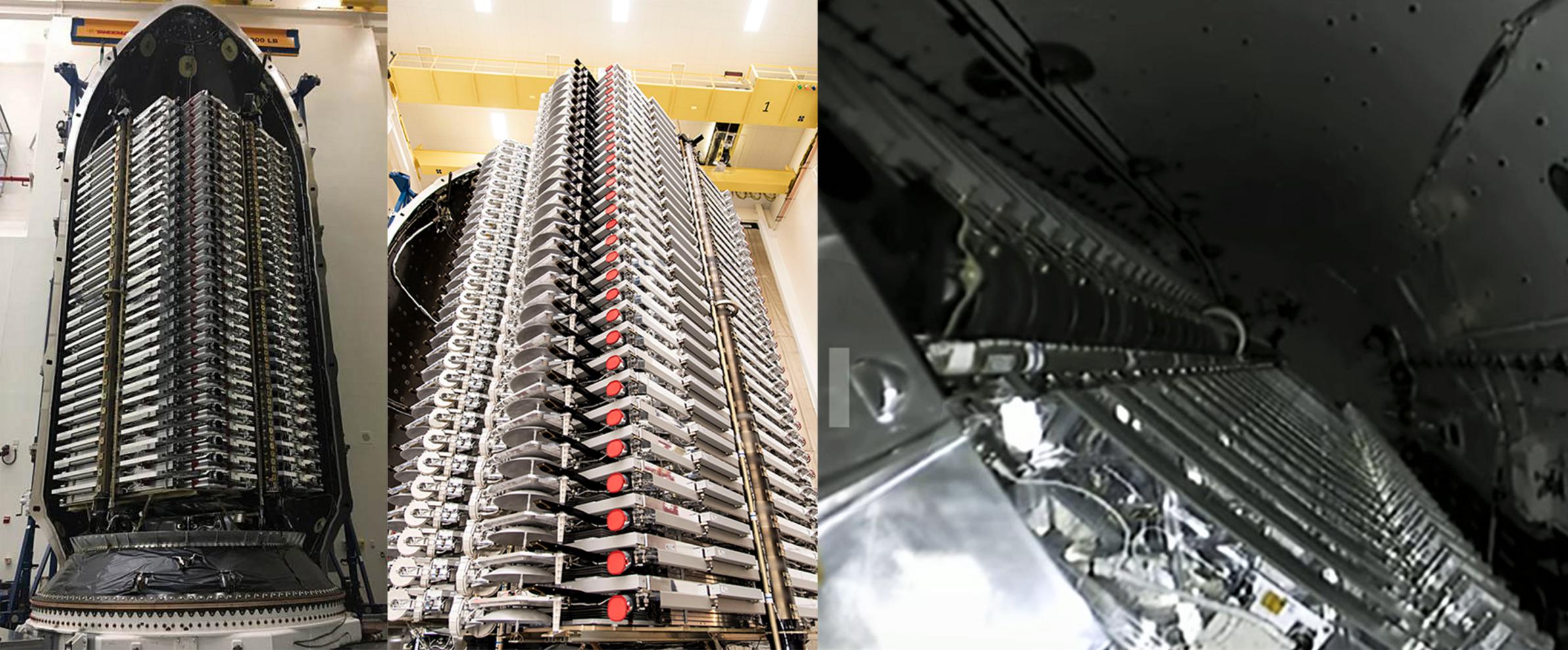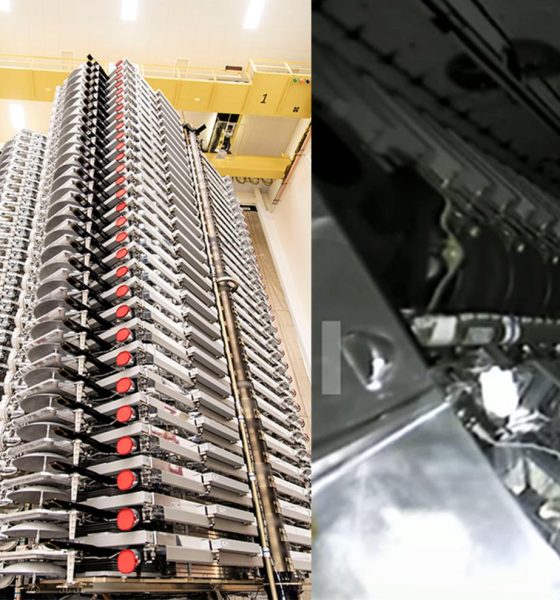CEO Elon Musk says SpaceX is churning out Starlink satellites faster than it can launch them, the best sign yet that the company is having some amazing success in what is already the most productive satellite factory in history.
Since SpaceX first revealed its radical flat-satellite Starlink design, stacking approach, and deployment mechanism back in May 2019, the company has successfully launched an incredible 300 satellites, ~290 of which are still functioning as intended. At this point, that means that Starlink is likely the largest satellite constellation in history by a factor of two, crushing the second largest’s ~150 satellites. Perhaps even more significant is the mass of SpaceX’s nine-month-old constellation, currently standing at more than 75 metric tons (165,000 lb) of satellites in orbit.
Despite the already awe-inspiring scale of SpaceX’s satellite internet constellation, the company’s Starlink factory is already so successful that the company is now unable to launch the spacecraft as quickly as they’re built. Given that SpaceX has maintained an average of ~1.3 Starlink launches per month since November 2019, many of which suffered significant delays as a result of weather or minor hardware issues, this likely means that SpaceX is building dozens more satellites than it can launch, probably creating its own internal launch manifest backlog as those surplus spacecraft pile up.
Considering the fact that SpaceX has gone from two prototype spacecraft to the proud owner of the largest satellite constellation in history in less than nine months, the fact that the company’s Starlink factory is already outpacing its launch capacity is arguably a good sign. While it’s likely that weather and hardware-related launch delays on the last few Starlink missions have made it harder than expected to stick to plans for an average of two Starlink launches per month, SpaceX isn’t falling that short of its classically lofty ambitions (a bit less than one Starlink launch every two weeks).
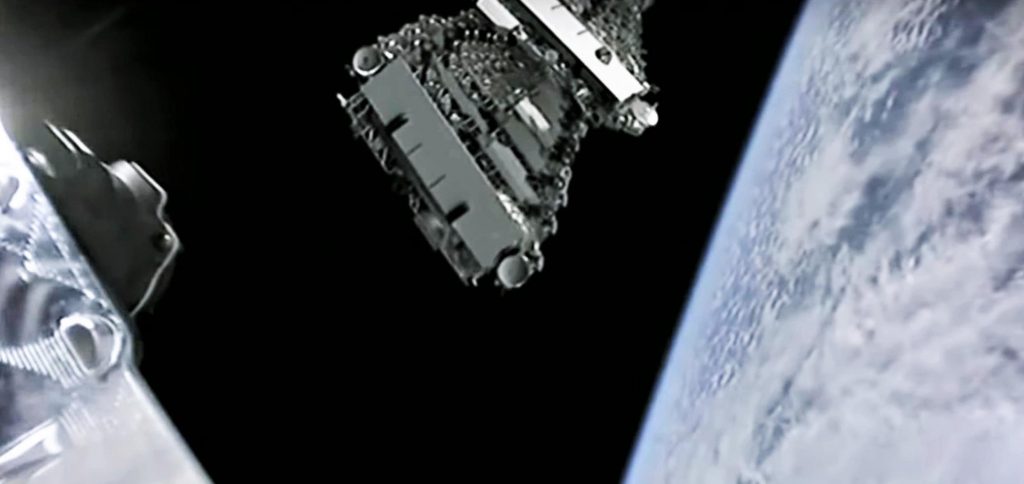
SpaceX may now be the first company in history to chronically suffer from its factories building more satellites than it can launch in a given time frame. In those terms, a surplus of flight-ready satellites is actually a highly desirable “problem” to have. Competitor OneWeb, for example, was forced to delay its first 34-satellite launch by two months after its new Florida factory suffered several production delays.
SpaceX, on the other hand, has to build almost twice as many satellites per launch, has effectively launched 35% of OneWeb’s entire constellation (~650 satellites) in the last three months alone, and still has an apparent backlog of satellites ready to head to orbit. As of March 3rd, SpaceX’s fifth launch of 60 upgraded Starlink v1.0 satellites and sixth launch overall (Starlink V1 L5 or Starlink-6) is scheduled to lift off no earlier than March 14th after slipping from February 14th, March 4th, and March 11th. The mission’s most recent delays were caused by an issue discovered in the Falcon 9 second stage assigned to launch Cargo Dragon’s CRS-20 mission, triggering SpaceX to swap it with Starlink V1 L5’s unaffected second stage.
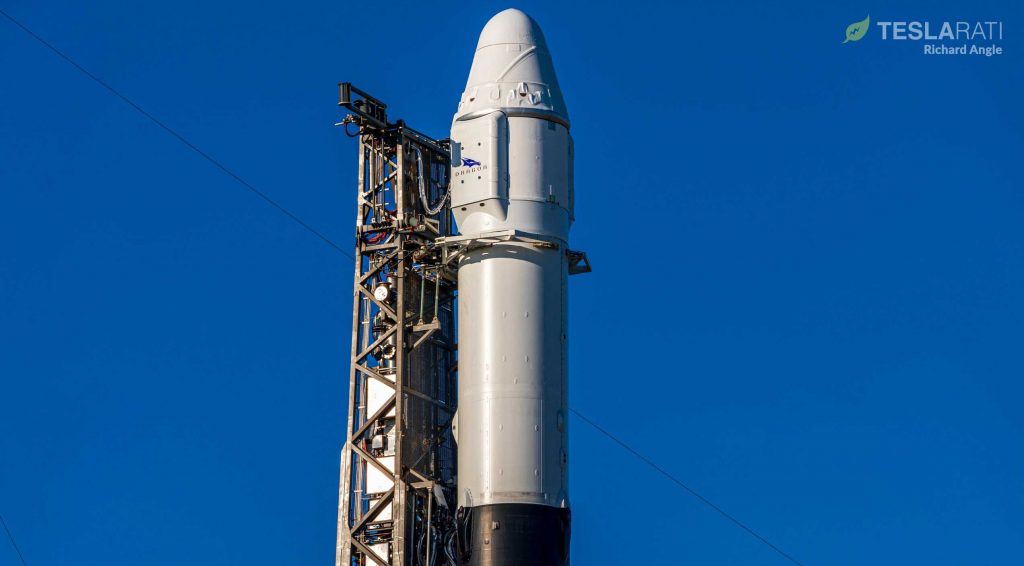
After Starlink V1 L5, SpaceX has more batches of 60 Starlink satellites that – given Musk’s comments – might already be stacked and ready for flight, both of which could potentially fly in March or April. In the midst of its Starlink launch ambitions, SpaceX has scheduled Florida’s first polar launch in half a century on March 30th, followed by a historic US Air Force launch and landing no earlier than (NET) April 27th.
If Cargo Dragon successfully lifts off this Friday, SpaceX will reach an average of ~1.9 weeks per launch, a cadence that – if maintained – would set the company up for at least 27 launches in 2020. With room for improvement after several weather-related days: so far, so good.
Check out Teslarati’s Marketplace! We offer Tesla accessories, including for the Tesla Cybertruck and Tesla Model 3.

News
Tesla discloses interesting collaboration partner for Supercharging
This BOXABL collaboration would be a great way to add a rest stop to a rural Supercharging location, and could lead to more of these chargers across the U.S.
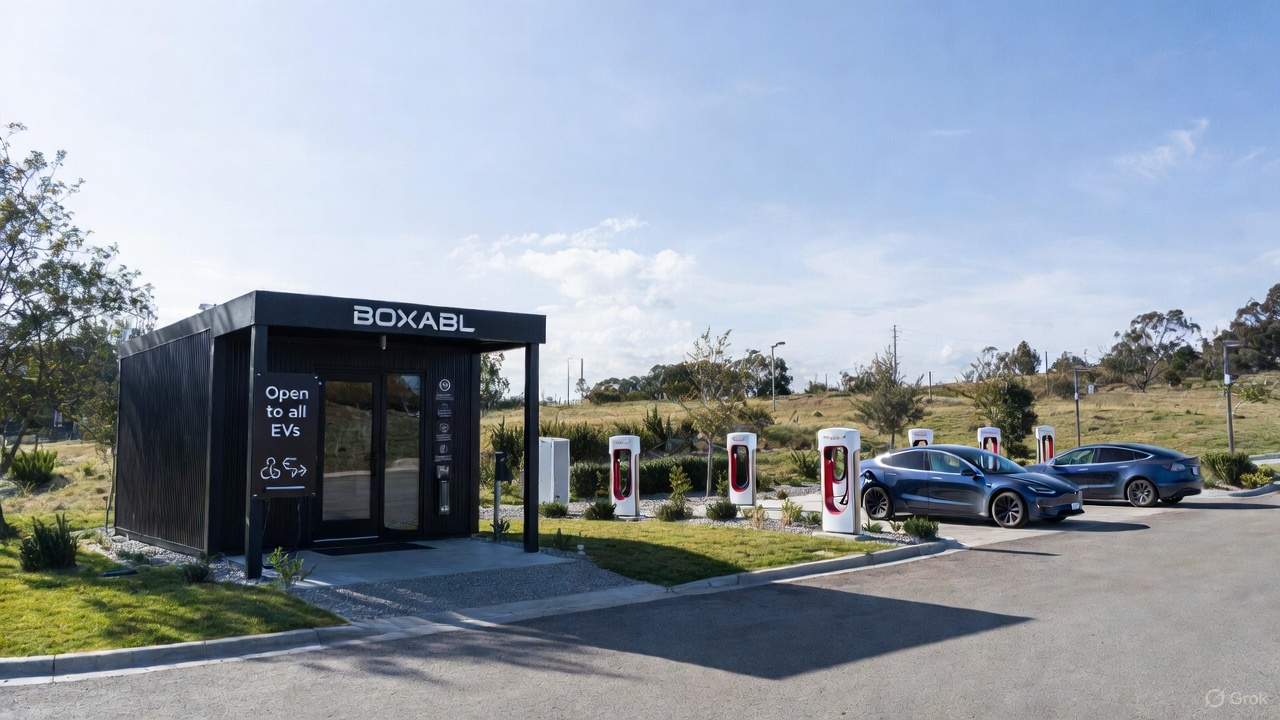
Tesla disclosed an interesting collaboration partner in an SEC filing, which looks like an indication of a potential project at Supercharger sites.
Tesla said on Tuesday in the filing that it was entering an agreement with BOXABL to design and build a Micromenity structure. Simply put, this is a modular building, usually a few hundred square feet in size, and it has been seen at Superchargers in Europe.
In Magnant, France, Tesla opened a small building at a Supercharger that is available to all EV owners. There are snacks and drinks inside, including ice cream, coffee, a gaming console, and restrooms. It gives people an opportunity to get up and out of their cars while charging.
This building was not built by BOXABL, but instead by bk World Lounges. It is likely the final Supercharging stop before people get to Paris, as it is located 250 kilometers, or 155 miles, from the City of Light.
Voir cette publication sur Instagram
Magnant has 56 stalls, so it is a large Supercharging stop compared to most. The building could be a sign of things to come, especially as Tesla has opened up larger Supercharger stations along major roadways.
It is for just a single building, as the Scope of Work within the filing states “a comprehensive package for one Micromenity building.”
NEWS: BOXABL, a company that creates modular, prefabricated buildings, has entered into an agreement with @Tesla.
This is Tesla formally contracting BOXABL to design, engineer, and build a pilot “Micromenity” structure, a compact, modular building unit.
While some info in the… pic.twitter.com/RabJczGpEp
— Sawyer Merritt (@SawyerMerritt) December 9, 2025
Superchargers are commonly located at gas stations, shopping centers, and other major points of interest. However, there are some stops that are isolated from retail or entertainment.
This BOXABL collaboration would be a great way to add a rest stop to a rural Supercharging location, and could lead to more of these chargers across the U.S.
Tesla has done a lot of really great things for Supercharging this year.
Along with widespread expansion, the company launched the “Charging Passport” this week, opened the largest Supercharger in the world in Lost Hills, California, with 168 chargers, opened the Tesla Diner, a drive-in movie restaurant in Los Angeles, and initiated access to the infrastructure to even more automakers.
Elon Musk
Tesla CEO Elon Musk confirms Robotaxi safety monitor removal in Austin: here’s when
Musk has made the claim about removing Safety Monitors from Tesla Robotaxi vehicles in Austin three times this year, once in September, once in October, and once in November.

Tesla CEO Elon Musk confirmed on Tuesday at the xAI Hackathon that the company would be removing Safety Monitors from Robotaxis in Austin in just three weeks.
This would meet Musk’s timeline from earlier this year, as he has said on several occasions that Tesla Robotaxis would have no supervision in Austin by the end of 2025.
On Tuesday, Musk said:
“Unsupervised is pretty much solved at this point. So there will be Tesla Robotaxis operating in Austin with no one in them. Not even anyone in the passenger seat in about three weeks.”
Musk has made the claim about removing Safety Monitors from Tesla Robotaxi vehicles in Austin three times this year, once in September, once in October, and once in November.
In September, he said:
“Should be no safety driver by end of year.”
The safety driver is just there for the first few months to be extra safe.
Should be no safety driver by end of year.
— Elon Musk (@elonmusk) September 4, 2025
On the Q3 Earnings Call in October, he said:
“We are expecting ot have no safety drivers in at least large parts of Austin by the end of this year.”
Finally, in November, he reiterated the timeline in a public statement at the Shareholder Meeting:
“I expect Robotaxis to operate without safety drivers in large parts of Austin this year.”
Currently, Tesla uses Safety Monitors in Austin in the passenger’s seat on local roads. They will sit in the driver’s seat for highway routes. In the Bay Area ride-hailing operation, there is always a Safety Monitor in the driver’s seat.
Three weeks would deliver on the end-of-year promise, cutting it close, beating it by just two days. However, it would be a tremendous leap forward in the Robotaxi program, and would shut the mouths of many skeptics who state the current iteration is no different than having an Uber.
Tesla has also expanded its Robotaxi fleet this year, but the company has not given exact figures. Once it expands its fleet, even more progress will be made in Tesla’s self-driving efforts.
News
SpaceX reportedly mulling IPO, eyeing largest of all time: report
“I do want to try to figure out some way for Tesla shareholders to participate in SpaceX. I’ve been giving a lot of thought to how to give people access to SpaceX stock,” Musk said.
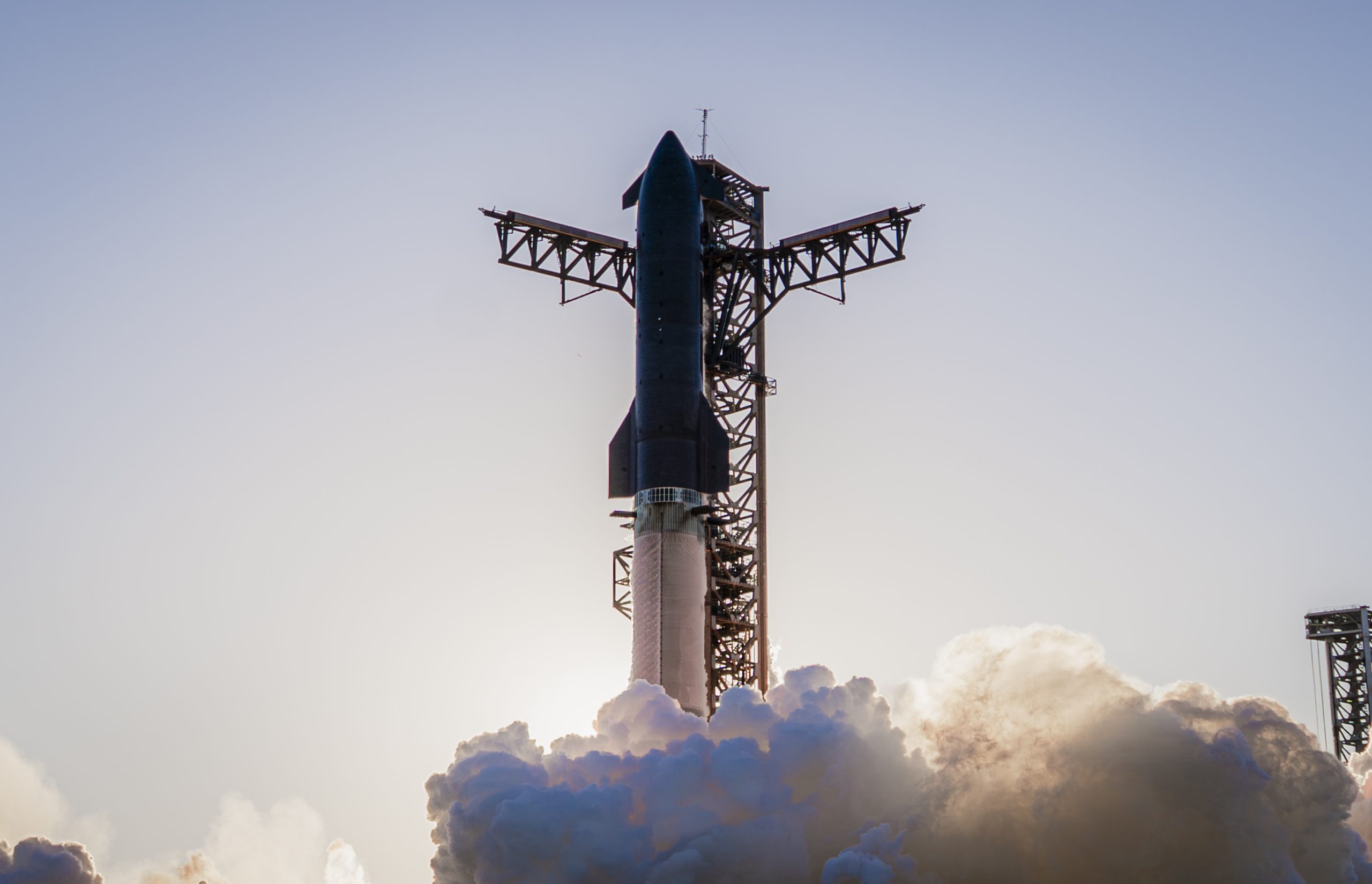
SpaceX is reportedly mulling an initial public offering, eyeing what would be the largest valuation at the time of availability of all time, a new report from Bloomberg said on Tuesday.
It is one of many reports involving one of Elon Musk’s companies and a massive market move, as this is not the first time we have seen reports of an IPO by SpaceX. Musk himself has also dispelled other reports in the past of a similar nature, including an xAI funding round.
SpaceX and Musk have yet to comment on the report. In the past, untrue reports were promptly replied to by the CEO; this has not yet gained any response, which is a good sign in terms of credibility.
However, he said just a few days ago that stories of this nature are inaccurate:
“There has been a lot of press claiming SpaceX is raising money at $800B, which is not accurate. SpaceX has been cash flow positive for many years and does periodic stock buybacks twice a year to provide liquidity for employees and investors. Valuation increments are a function of progress with Starship and Starlink and securing global direct-to-cell spectrum that greatly increases our addressable market. And one other thing that is arguably most significant by far.”
There has been a lot of press claiming @SpaceX is raising money at $800B, which is not accurate.
SpaceX has been cash flow positive for many years and does periodic stock buybacks twice a year to provide liquidity for employees and investors.
Valuation increments are a…
— Elon Musk (@elonmusk) December 6, 2025
Musk has discussed a potential IPO for SpaceX in recent months, as the November 6 shareholder meeting, as he commented on the “downsides” of having a public company, like litigation exposure, quarterly reporting pressures, and other inconveniences.
Nevertheless, Musk has also said he wants there to be a way for Tesla shareholders to get in on the action. At the meeting in early November, he said:
“I do want to try to figure out some way for Tesla shareholders to participate in SpaceX. I’ve been giving a lot of thought to how to give people access to SpaceX stock.”
Additionally, he added:
“Maybe at some point., SpaceX should become a public company despite all the downsides of being public.”
Musk has been historically reluctant to take SpaceX public, at times stating it could become a barrier to colonizing Mars. That does not mean it will not happen.
Bloomberg’s report cites multiple unidentified sources who are familiar with the matter. They indicate to the publication that SpaceX wants to go public in mid-to-late 2026, and it wants to raise $30 billion at a valuation of around $1.5 trillion.
This is not the first time SpaceX has discussed an IPO; we reported on it nine years ago. We hope it is true, as the community has spoken for a long time about having access to SpaceX stock. Legendary investor Ron Baron is one of the lucky few to be a SpaceX investor, and said it, along with Tesla, is a “lifetime investment.”
Tesla bull Ron Baron reveals $100M SpaceX investment, sees 3-5x return on TSLA
The primary driver of SpaceX’s value is Starlink, the company’s satellite internet service. Starlink contributes 60-70 percent of SpaceX’s revenue, meaning it is the primary value engine. Launch services, like Falcon 9 contracts, and the development of Starship, also play supporting roles.
